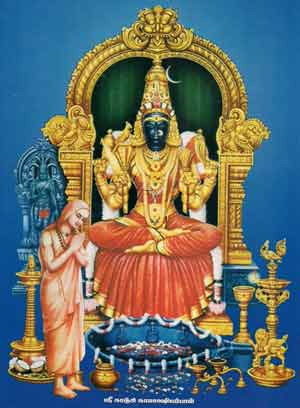Adi Shankaracharya & His Connection with Kanchipuram
A book By Sri A. Kuppuswami, B.A., B.T.
|
SRI SHANKARACHARYA AND HIS CONNECTION WITH KANCHIPURAM |
|
 |
APPENDIX -I (1) Mahamahopadhyaya Lakshmanasuri in his Bhagavatpadabhyudayam (Sanskrit) says:
Guru (Sankara) consecrated Sricakra in front of Sri Kamaksi and also established a mantha there (at Kanchi). (2) Late Dr. Ganganatha Jha, Mahamahopadhyaya and former Vice – Challencor of the Allahabad University), in an article in the ‘Bhaktakusumanjali’, presented to the late Sri Chandrasekhara Bharati Swami, Acarya of Sringeri Math (1912 – 1954) has written : |
“The establishment of seats of worship at places like Kanchi, Sringeri etc., where his successors carry on the worship of the deities even today in all its fullness is a further proof of the view held by the Acarya that due performance of rites is an integral feature of his teaching.” (Page 1, Bhaktakusumanjali – English section – printed by Vani Vilas Press, Srirangam – 1938). (3) Late mahamahopadhyaya N.s.Anantakrishna Sastri, (a former Professor of Vedanta of the Calcutta University), in an article is Sanskrit, contributed to the same ‘Bhaktakusumanjali noted above has stated that Sankara founded several pithas during the course of his digvijaya (at different places) and among them five stand predominant and that one of these five is the pitha at Kanchi. (4) Late K.A.Nilakanta Sastri (Professor of Indology, Mysore) has made the following observations in his ‘History of South India’ (Page 428, Fourth Edition 1975, 1987, III Edition -1966, page 410):- “He (Sankara) founded a number of mathas in different parts of India, the best known being those of Sringeri, Dvaraka, Badrinath, Puri and Kanchi.” (5)Late S.S. Suryanarayana Sastry, a former Professor of Philosophy of the University of Madras, in his work ‘Sankaracharya, Philosopher and Mystic’ (1938), states “Sri Sankara established several mutts the most notable of which are perhaps those of Sarada Peeta and Kamakoti Peeta. (6)Mahamahopadhyaya, Padmavibhushan Gopinath Kaviraj observes (in page 113 – of his work, ‘Bharatiya Samskriti aur Sadhana’:-
(For his own residence Acarya Sankara founded a seat in the Kanchi Kamakoti Pitha). (7) In the Karnataka Visesasancika (Published by the Sankaravijaya Karyalaya, Mysore 1935), Saligram Srikanta Sastri, has specified about Adya Shankaracharya’s own asrama at Kanchi. (8) Late Dr. Sir. C.P. Ramaswami Iyer a veteran Jurist, a former Dewan of the Travancore State and a prominent citizen of our country, in his brochure ‘World Religious – a study in Synthesis’, (Pulished by the Government Press, Trivandrum – 1942)Refers to Kanchi as one of Sankara’s capitals and his establishment of a math at Kanchi. (9) In the Chronology of Nepal History (Reconstructed) 1953, by Sri Kota Venkatachalam, the following information about the Sankarite Institution at Kanchi is found:- “The Kamakoti Pitha at Kanchi was founded in Vaisakha Sukla Purnima of the Year Siddharti with Adi Sankara himself as the first Acarya – (2020 of Kali era -482 B.C.)” (10) Bharatiya Vidya Bhavan (Bombay) has published a short work by name ‘Indian Chronology’, written by Dr.S.S. Triveda, Ph.D., (1959). The work is a mere compilation of dates of historical events and personages from ancient times. In page 91 of the work, dates are given for establishment of institutions by Shankaracharya. There it is stated that the Kamakoti Pitha at Kanchi was founded on Vaisakha, Sukla Full Moon in Kali Saka 2620 = 482 B.C. with Sri Sankara Bhagavatpada himself as the first Acarya.” (11) Dr.T.M.P. Mahadevan Professor of Philosophy, University of Madras, has observed (in his broadcast talk, published under the caption ‘Contribution of the South to the Cultural Heritage of India’ by the Publication Division of the Ministry of Information and Broadcasting. Government of India -1961), that “he (Sankara) set up at cardinal points of the country, monastic institutions which would protect the spiritual interests of the race. Of these institutions, five are the most important. Except the one at Badari in the Himalayas, the other four are in the peninsular part of India at Puri, Dwaraka, Sringeri and Kanchi.” (12) Prof. Baladev Upadhyaya, former Head of the Purana and Itihasa Section of the Benares Hindu University, has written a biography of Sankara Sri Shankaracharya,’ – in Hindi (Published by the Hindustani Academy of Allahabad – 1963). In the 16th Pariccheda (Chapter) of the work having the heading ‘Mathom Kavivaran’ (Details about maths) the following information is found:- “By him (Shankaracharya) in southern Bharat, at Kanchi, one of the seven Moksapuries, a matha has been established” – page 191. (13). The Chengleput District Gazetteer, published by Charles Stuart Crole I.E.S. in 1879 A.D. has the following details:- “The first of these wandering controversialists was Shankarachari(who flourished in the 9th or 10th century?) and wandered all over India, establishing the dying religion, Saivite faith and fanning the persecution before which the last disciple of Sakiya fled. He paid particular attention to Conjeevaram where he worked many miracles and founded a Matham or Monastery.” (Chingleput District Gazetteer Ethnological, Religious and Social page 86 and 87). “A number of Mathas in the name of the founder Acharya were established in later years. But the Kanchi Kamakoti Peetha is almost as old as the other main Mathas.”In Pages 48,49, it is stated “A study of the literature on the life of the Acharya makes it clear that after establishing the four Mathas, the Acharya did stay at Kanchi Kamakoti for some years. This was towards the end of his life.” |
|
| Book Index Page |  |
Appendix II - Extracts from Madras University Historical Series No. 15 |
Back to Page - Focus Adi Shankaracharya

